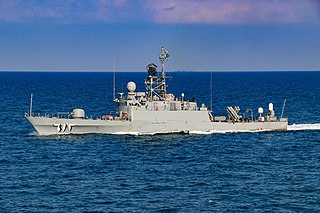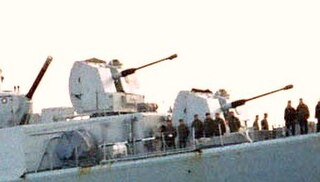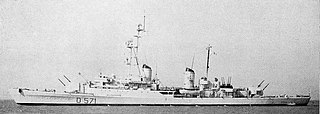Design and description
The Centauro-class ships measured 103.1 meters (338 ft 3 in) long overall, with a beam of 12 meters (39 ft 4 in) and a draft of 3.8 meters (12 ft 6 in). Their crew numbered 207 officers and enlisted men. [1] They displaced 1,680 metric tons (1,650 long tons ) at standard load and 2,120 metric tons (2,090 long tons) at deep load. [2] The ships had two Tosi geared steam turbines, each driving one propeller shaft using steam provided by two Foster Wheeler water-tube boilers. The turbines were rated at a total of 22,000 shaft horsepower (16,000 kW ) for a speed of 26 knots (48 km/h; 30 mph). The Centauros had a range of 3,000 nautical miles (5,600 km; 3,500 mi) at 20 knots (37 km/h; 23 mph). [1]
The main armament of the Centauro-class ships consisted of four OTO Melara 76-millimeter (3 in) Allargato dual-purpose (DP) guns in two twin-gun mounts, one each fore and aft of the superstructure. The guns were positioned over-and-under in the mount and were protected against spray by a gun shield. Four 40-millimeter (1.6 in) Bofors AA guns in twin mounts were positioned on the rear superstructure. The ships were also armed with two fixed single tubes amidships for 533-millimeter (21 in) torpedoes. A triple-barrel 305-millimeter (12 in) Menon anti-submarine (ASW) mortar mount was located in front of the superstructure, superfiring over the forward 76-millimeter gun mount. The ships were also equipped with four short-barrelled Menon ASW mortars, two on each side abreast the rear superstructure, and a depth charge rail on the stern. [1]
The main guns were italian and the anti-air guns were american, while the sensors and fire-control systems (FCS) were Italian, although based on American equipment. The frigates were initially fitted with a Microlambda MLA-1 early-warning radar and the OTO Melara guns used a MTL-4 gunnery radar on the OG 2 director, an Italian version of the American Mark 39 radar used in the Mark 57 FCS. The MLA-1 systems were replaced by American AN/SPS-6 radars in all four ships by 1960. The Bofors guns used the OG 1 FCS, based on the Mark 51 FCS. A SQS-11A sonar provided data to the anti-submarine weapons. [3]
Centauro was rearmed in 1970–1971 with three of the first generation of the OTO Melara 76 mm Compact DP guns in single-gun mounts to replace the unsatisfactory Allargato guns and the Bofors guns. The Allargatos were hard to load, difficult to maintain and the mount lacked a sufficient number of ready rounds. The torpedo tubes and two of the short barrel Menon mortars were removed in exchange for two rotating triple tube mounts, one on each side, for 324-millimeter (12.8 in) Mark 44 torpedoes. The sensors and fire-control suites were also upgraded, a SQS-36 sonar being added as was a MM/SPQ-2 radar. An OG 3 FCS with an Orion RTN-7X radar replaced the OG 2 director and its Mark 39 radar. [3]

The Santa María class of guided missile frigates is the Spanish Navy's designation for six warships based on the United States Oliver Hazard Perry-class frigates. Spanish ships have a slightly bigger beam and were built with a greater weight reserve for future improvements. Other changes from the basic model include Meroka replacing Phalanx and a RAN-12L air search radar to provide low horizon coverage against sea skimmers cueing the Meroka CIWS mount. The Nettunel EW suite replaced the SLQ-32 system fitted aboard US ships. The first ship Santa Maria entered service in 1986.
The Andrea Doria class were helicopter cruisers of the Italian Navy. Italy's first major new designs of the post–World War II era, these ships were primarily designed for anti-submarine warfare tasks. Initially planned for three ships, the two ships that were constructed, Andrea Doria and Caio Duilio served until 1991 in both active and training capacities. The Andrea Doria class formed the basis for the larger Vittorio Veneto that followed them.

Santa María (F81) is the lead ship of six Spanish-built Santa Maria-class frigates of the Spanish Navy, based on the American Oliver Hazard Perry class design. The vessel was constructed in 1982 and was launched on 11 November 1984. Santa María was commissioned on 12 October 1986. The frigate has served in NATO maritime operations.

Vittorio Veneto was a helicopter cruiser that served with the Italian Navy. Originally intended to be a class of two ships specifically designed for anti-submarine warfare (ASW), only Vittorio Veneto entered into service in 1969, its sister ship Italia being cancelled. Vittorio Veneto was placed into reserve in 2003 and decommissioned in 2006. This ship has the same general layout as the smaller Andrea Doria-class helicopter cruisers, but with two elevators in the flight deck and the hangar below, rather than with the hangar as part of the superstructure. It was named for the decisive Battle of Vittorio Veneto which ended World War I on the Italian front.

The Claud Jones-class destroyer escorts were four destroyer escorts built for the United States Navy in the late 1950s. These ships were a diesel-powered version of the earlier Dealey class and were designed with the aim of producing a cheaper ship suitable for rapid production in wartime. These ships also had reduced armament and speed compared to their predecessors. They were not seen as effective anti-submarine warfare vessels by the United States Navy and were sold after only 15 years service to the Indonesian Navy.

The João Belo class, also known as Comandante João Belo class, is a class of four frigates of French design, based on the Commandant Rivière class but fitted for tropical service. Ordered by the Portuguese Navy in 1964, the four ships of this class were constructed at the shipyard in Nantes, France between 1965 and 1967. The first ship entered Portuguese service in 1967. The frigates were used for ocean patrol of Portuguese colonies and later, joined NATO's STANAVFORLANT unit. The first unit was discarded in 2003, followed by a second in 2004. The final two ships were taken out of service in 2008 sold to the Uruguayan Navy. The third ship was discarded in 2021, and the last ship was decommissioned on 12 August 2022.

The Impetuoso class were the first post-World War II destroyers built for the Italian Navy. The two ships were ordered in February 1950, entered service in 1958 and were retired in the early 1980s.

The Badr class is a class of corvette built by the United States and operated by the Saudi Navy. The class has been relegated to a coastal defence role following the modernisation of the Saudi fleet. There are four vessels in service; Badr, Al Yarmook, Hitteen and Tabuk.

The Mackenzie-class destroyer was a class of warship used by the Royal Canadian Navy and Canadian Forces from the 1960s–1990s. Six such ships were envisioned, of which four were completed to this specification. The last two hulls were completed to the post DDH conversion St. Laurent-class design ; they were designated as the Annapolis class instead. The four Mackenzie-class destroyers spent most of their service in the Pacific Ocean, used primarily in a training role. Their only significant update was the DELEX program, which was completed between 1982 and 1985 and updated their navigational radar and their sonar.

The Annapolis-class destroyer escort was a two-ship class of destroyer escorts that saw service with the Royal Canadian Navy and Canadian Forces from the 1960s to the 1990s. The final version of the St. Laurent-class design, the class was used extensively for anti-submarine warfare purposes. Both ships were sunk as artificial reefs after being retired, one on each coast of Canada.

Tapi-class corvettes are a class of two corvettes that were built for the Royal Thai Navy in the early 1970s.

The 76mm/L62 Allargato is a single barrel, medium caliber, dual purpose automatic naval cannon designed and produced in the 1960s by the Italian defence firm of OTO-Melara as the cannon armament for all medium and large warships built for the Italian Navy in that decade. Currently, the gun remains in service with Italy's Cassiopea-class patrol vessels but has otherwise been largely replaced by the Otobreda 76 mm series of cannons.

The Dealey-class destroyer escorts were the first post-World War II escort ships built for the United States Navy.

The Admiral Pereira da Silva class of frigates, also known as Admiral-class frigates, were in the service of the Portuguese Navy between 1966 and 1985. The class was based on the Dealey-class destroyer escort of the United States Navy. The three ships of the class were built in Portugal, at the Lisnave shipyards and the shipyards of Viana do Castelo. The construction of the ships was part of the effort of Portugal to expand its fleet in the face of unrest in the empire and was financed by the United States via the Mutual Defense Assistance Program. Financial problems prevented them from ever being modernised and they were deleted in 1989.

HNLMS Kortenaer (F807) was a frigate of the Kortenaer class. The ship was in service with the Royal Netherlands Navy from 1978-97 and today serves as HS Kountouriotis with the Hellenic Navy. The frigate was initially named after Dutch naval hero Egbert Bartholomeusz Kortenaer and then after Pavlos Kountouriotis, distinguished Admiral of the Hellenic Navy, responsible for Greek naval victories in the Aegean Sea that secured the Aegean for Greece during the First Balkan War. The ship's radio call sign was "PADA".

HNLMS Callenburgh (F808) was a frigate of the Kortenaer class. The ship was in service with the Royal Netherlands Navy from 1979-1994. She was named after Dutch naval hero Gerard Callenburgh, and the ship's radio call sign was "PADB".

The Centauro class consisted of four frigates built for the Italian Navy during the 1950s. They entered service in 1957, with the last one being stricken in 1985.

Canopo was one of four Centauro-class frigates built for the Italian Navy in the 1950s.

Castore was one of four Centauro-class frigates built for the Italian Navy in the 1950s.

Cigno was one of four Centauro-class frigates built for the Italian Navy in the 1950s.
This page is based on this
Wikipedia article Text is available under the
CC BY-SA 4.0 license; additional terms may apply.
Images, videos and audio are available under their respective licenses.


















